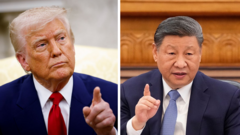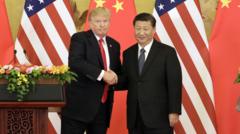The US and China have come to an agreement to lower tariffs on imported goods, signaling a possible de-escalation of their trade war. This deal, announced after crucial talks, involves cancellation and suspension of select tariffs, and could potentially foster cooperation between the two nations.
US-China Reach Tariff Agreement, Marking Potential Peace in Trade War

US-China Reach Tariff Agreement, Marking Potential Peace in Trade War
A new truce between the US and China aims to reduce import tariffs, indicating a significant turn in their ongoing trade conflict.
The US and China have confirmed a significant agreement to reduce import tariffs on goods traded between the two powerhouses, reflecting a new phase in their ongoing trade war. This truce is viewed as a major step toward de-escalating tensions that have reverberated across global economies, including in the UK.
As part of the deal, the US will cut tariffs on Chinese imports from 145% to 30%, while China will lower tariffs on some US products from 125% to 10%. The agreement also includes a 90-day suspension of certain tariffs until May 14, 2024. In addition, China has ceased and eliminated specific non-tariff measures, such as its halt on key mineral exports to the US, implemented earlier in response to the original tariffs set by the Trump administration.
However, US trade measures still involve an additional 20% tariff component aimed at pressuring China to combat the illegal fentanyl trade, a potent opioid. This landmark announcement followed discussions in Switzerland — the first official talks between the two nations since President Trump reignited the trade conflict.
The future of this deal is uncertain, particularly after the 90-day period. While there’s potential for tariffs to be reinstated, the current arrangement is a considerable improvement, reducing US tariffs to 54% and Chinese tariffs to 34% if negotiations do not yield further agreements. US Treasury Secretary Scott Bessent noted both nations' desire to avoid "decoupling," indicating a mutual interest in fostering cooperative negotiations.
The import-export dynamics between the US and China remain extensive, with the US exporting mostly agricultural products like soybeans and importing a variety of goods from China, primarily electronics and smartphones. The desire to rectify the trade imbalance has historically motivated US tariffs, aimed at boosting domestic manufacturing.
While the agreement has drawn mixed reactions and claims of victory from both parties, perspectives diverge on the implications of the truce. Analysts suggest that despite the US still having a significant tariff on Chinese imports, the psychological edge has shifted slightly towards China. Observers will be watching closely as further negotiations unfold, anticipating how this agreement could reshape future trade dynamics.























